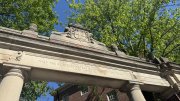The University announced today that in partnership with MIT, Mass General Brigham hospital, and a group of public and nonprofit organizations in Eastern Massachusetts, it would purchase the power produced by two large renewable energy projects: a 200 megawatt (MW) solar facility in Texas and a 208 MW wind facility in North Dakota. The arrangement is known as a virtual power purchase agreement, since the power generated—1.3 million megawatt hours annually by 2026—will be distributed within the grids where it is produced, rather than transmitted to Massachusetts.
The arrangement allows the purchasers to verifiably offset their use of fossil fuels—both in terms of greenhouse gas emissions and the atmospheric pollutants generated during combustion of such fuels—during a period of transition to clean energy. Harvard has pledged to be fossil-fuel neutral by 2026, an interim goal that this virtual power purchase agreement (VPPA) will help the University achieve as it seeks to become truly fossil-fuel free by 2050. As reported last week, Harvard has been actively pursuing electrification of the campus during renovations and new construction.
The VPPA commits Harvard and its partners, known collectively as the Consortium for Climate Solutions, to purchase all the power produced at the two sites for the next 15 to 20 years at rates tied to the market. The 200 MW Big Elm Solar project in Bell County, Texas, began operating this year, and the 208 MW Bowman Wind project in Bowman County, North Dakota, is expected to come online in 2026. Both are owned and operated by Apex Clean Energy, headquartered in Charlottesville, Virginia.
The agreement will allow Harvard to offset the greenhouse gas (GHG) emissions attributable to all the electricity that it uses annually: nearly half of its total GHG emissions. As campus electrification proceeds, Harvard’s needs for this kind of offset will also grow, and its emissions footprint will shrink.
The assets being purchased by Harvard and its partners are known as renewable energy certificates (RECs). RECs lower an organization’s carbon footprint, by allowing it to purchase the carbon mitigation benefits associated with electricity generated from existing renewable sources. Harvard’s Fossil Fuel-Neutral by 2026 subcommittee, comprised of faculty and administrators, wanted Harvard’s purchases of RECs to go further, specifying that they should involve the creation of new sources of renewable energy, thus ensuring displacement of fossil-fuel-based energy production, and a commensurate reduction not only in carbon emissions but also atmospheric pollutants known to harm human health. The Apex projects, according to University administrators, would not have occurred without the support of the Consortium, which was formed in 2020. Other members (participating through a collective called PowerOptions) include the City of Cambridge, Beth Israel Lahey Health, Boston Children’s Hospital, Dana-Farber Cancer Institute, Tufts University, the Massachusetts Convention Center Authority, WGBH, and the Museum of Fine Arts, Boston.
According to a University statement, during the next 15 years the two projects will generate approximately $64 million in tax revenue in Texas and North Dakota, “750 jobs during construction, and a new and long-term source of income for local farmers and landowners [through land leases] totaling $100 million.”
“Investing in new large-scale renewables marks a significant step forward for Harvard in its commitment to a clean energy future,” said executive vice president Meredith Weenick. “By founding the Consortium with MIT, MGB, and [other] members, we are not only catalyzing the transition to a cleaner grid but also demonstrating a collaboration model that will enable a variety of nonprofit organizations and municipalities to work together to address the urgent challenges of climate change.”









